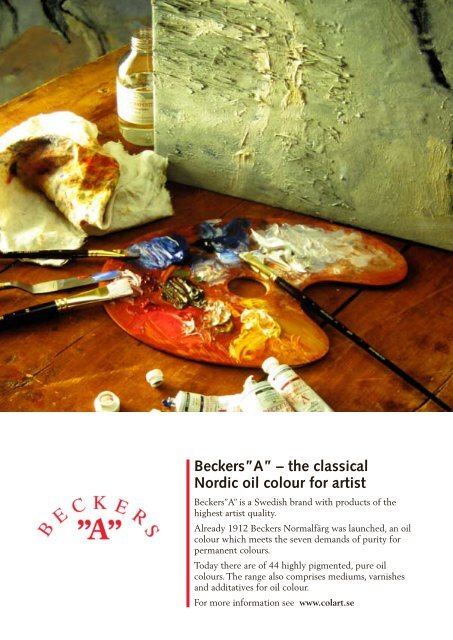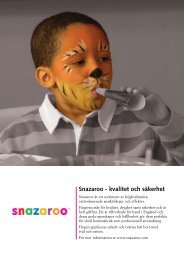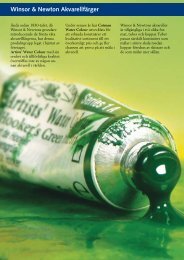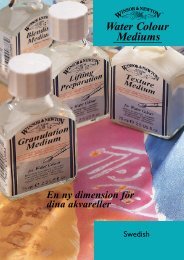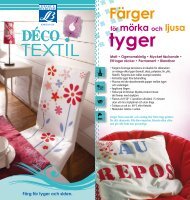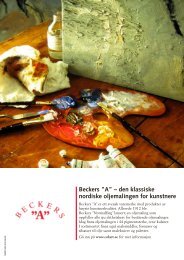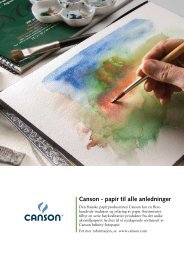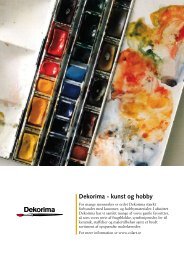Beckers”A” – the classical Nordic oil colour for artist - Colart
Beckers”A” – the classical Nordic oil colour for artist - Colart
Beckers”A” – the classical Nordic oil colour for artist - Colart
Create successful ePaper yourself
Turn your PDF publications into a flip-book with our unique Google optimized e-Paper software.
<strong>Beckers”A”</strong> <strong>–</strong> <strong>the</strong> <strong>classical</strong><br />
<strong>Nordic</strong> <strong>oil</strong> <strong>colour</strong> <strong>for</strong> <strong>artist</strong><br />
<strong>Beckers”A”</strong> is a Swedish brand with products of <strong>the</strong><br />
highest <strong>artist</strong> quality.<br />
Already 1912 Beckers Normalfärg was launched, an <strong>oil</strong><br />
<strong>colour</strong> which meets <strong>the</strong> seven demands of purity <strong>for</strong><br />
permanent <strong>colour</strong>s.<br />
Today <strong>the</strong>re are of 44 highly pigmented, pure <strong>oil</strong><br />
<strong>colour</strong>s. The range also comprises mediums, varnishes<br />
and additatives <strong>for</strong> <strong>oil</strong> <strong>colour</strong>.<br />
For more in<strong>for</strong>mation see www.colart.se
Beckers Normalfärg<br />
Beckers Normalfärg consists of carefully selected<br />
<strong>colour</strong> pigments mixed with <strong>oil</strong>, usually linseed<br />
<strong>oil</strong>. The <strong>colour</strong> is processed (ground) several times<br />
through metal or stone rolls to achieve a supple<br />
consistence. The <strong>colour</strong> dries when <strong>the</strong> <strong>oil</strong> oxidizes,<br />
which is a slow process. This means that <strong>the</strong> <strong>oil</strong> has<br />
a long drying time.<br />
Beckers Normalfärg is available in 44 <strong>colour</strong>s.<br />
All <strong>colour</strong>s are intermixable with each o<strong>the</strong>r. The<br />
Normal Colour Scale is meant to provide ample<br />
possibility to mix and create exactly <strong>the</strong> <strong>colour</strong> you<br />
want. There<strong>for</strong>e <strong>the</strong> high pigment loading is<br />
an absolute demand.<br />
History<br />
The origin of Beckers Normalfärg comes from <strong>the</strong><br />
German Scientist Keim and his standards regarding<br />
permanent <strong>colour</strong>s of <strong>the</strong> highest pigment quality.<br />
Beckers Normalfärg has been produced since 1912.<br />
Early it became <strong>the</strong> most popular <strong>oil</strong> <strong>colour</strong> among<br />
Swedish <strong>artist</strong>s. Several generations of Scandinavian<br />
Colour Square<br />
Above <strong>the</strong> full <strong>colour</strong> is shown,<br />
not mixed and below mixed<br />
with 50% white<br />
Colour number, name and series<br />
The higher <strong>the</strong> serial number, <strong>the</strong> more<br />
expensive <strong>the</strong> pigment and <strong>colour</strong><br />
Tube size<br />
ml <strong>colour</strong><br />
Quality Stamp<br />
Shows that Beckers Normalfärg<br />
is of <strong>the</strong> highest <strong>artist</strong> quality<br />
Beckers Normalfärg<br />
Beckers ”A” - 2<br />
<strong>artist</strong>s have used <strong>the</strong> <strong>colour</strong>s, being confident that <strong>the</strong>ir<br />
work will last.<br />
Today Beckers “A” is produced in ColArt’s own<br />
factories in France and England.<br />
Quality demands <strong>for</strong> Beckers Normalfärg<br />
1 Technical Purity<br />
Nothing is added to <strong>the</strong> pure <strong>colour</strong><br />
2 Lightfastness<br />
Will not fade or o<strong>the</strong>rwise change when exposed<br />
to daylight<br />
3 Air Permanence<br />
Will not change under athmospherical influence<br />
4 Oilfastness<br />
Insoluble in <strong>oil</strong> to avoid bleeding<br />
5 Water Permanence<br />
Insoluble in water<br />
6 Mixing Permanence<br />
The components of <strong>the</strong> <strong>colour</strong> should not react<br />
chemically when mixed with each o<strong>the</strong>r<br />
7 Lime fastness<br />
Endures lime in mural painting<br />
EAN code<br />
The underlined<br />
figures are <strong>the</strong><br />
product code<br />
Transparent/ Opaque<br />
Shows if <strong>the</strong> <strong>colour</strong> is transparent<br />
or opaque<br />
Lightfastness<br />
The highest lightfastness. Will not<br />
fade or change in daylight<br />
Pigment<br />
First <strong>the</strong> pigment name<br />
<strong>the</strong>n <strong>the</strong> chemical name<br />
Binder<br />
The <strong>oil</strong> that binds <strong>the</strong> pigment in<br />
<strong>the</strong> <strong>colour</strong><br />
Distributor (on <strong>the</strong> side of <strong>the</strong> tube)<br />
ColArt Sweden AB, Stockholm, Sweden<br />
Production Country<br />
Label Code<br />
Batch Number<br />
Engraved number from <strong>the</strong><br />
factory, used at quality control.
Colour Mixing<br />
Without light, no <strong>colour</strong>. It is only when light<br />
meets an object that we are able to see its <strong>colour</strong>.<br />
3 Primary Colours<br />
There are three primary <strong>colour</strong>s: yellow, red<br />
and blue. In Becker´s <strong>colour</strong> scale you can use e.g.<br />
220 Kadmiumgul ljus, 315 Kadmiumröd mörk and<br />
415 Ultramarinblå.<br />
With <strong>the</strong>se three <strong>colour</strong>s and black and white you<br />
could in principle mix all o<strong>the</strong>r <strong>colour</strong>s. But this<br />
would be ra<strong>the</strong>r time consuming and you would<br />
also lose <strong>the</strong> character that certain <strong>colour</strong>s have<br />
because of <strong>the</strong>ir pigments. The total consumption<br />
of <strong>colour</strong> will be <strong>the</strong> same so it is appropriate to<br />
choose more <strong>colour</strong>s <strong>for</strong> your palette.<br />
Beckers ”A” - 3<br />
Secondary Colours<br />
Orange, violet and green are secondary <strong>colour</strong>s.<br />
Those are <strong>colour</strong>s which you obtain by mixing two<br />
primary <strong>colour</strong>s.<br />
Some examples of secondary <strong>colour</strong>s from Beckers<br />
are 230 Kadmiumorange, 405 Koboltviolett and<br />
515 Beckers grön.<br />
White and black<br />
When you paint you normally use a lot of white.<br />
Colours mixed with white will get a pastel character.<br />
Titanvit is an intense white with a lot of covering<br />
strength and a medium drying time.<br />
Zinkvit on <strong>the</strong> o<strong>the</strong>r hand is more transparent, has<br />
a colder, bluish tone and dries somewhat slower.<br />
Blandad vit takes <strong>the</strong> best of both and creates a<br />
golden “middle white”.<br />
Svart is used to subdue a <strong>colour</strong> but can make <strong>the</strong><br />
original <strong>colour</strong> appear a little dirty. Try instead to mix<br />
with a dark earth <strong>colour</strong>, <strong>for</strong> example 670 Obränd<br />
Umbra, and compare <strong>the</strong> results.<br />
Earth <strong>colour</strong>s<br />
Earth Colours have natural origin and we can easily<br />
associate to <strong>the</strong> nature of <strong>for</strong>eign countries. Terra<br />
di Sienna <strong>–</strong> earth from Sienna, Verona Grönjord <strong>–</strong><br />
<strong>the</strong> green earth in <strong>the</strong> surroundings of Verona and<br />
o<strong>the</strong>rs more. The unique thing about those <strong>colour</strong>s<br />
is <strong>the</strong>ir earth character. It is <strong>the</strong>re<strong>for</strong>e difficult to<br />
create earth <strong>colour</strong>s by mixing primary or secondary<br />
<strong>colour</strong>s, as <strong>the</strong>y are in <strong>the</strong>ir nature bright.
A little painting school<br />
Choose your motive and lightly sketch in <strong>the</strong> main<br />
outlines on to your support. Use a thin stick of<br />
charcoal and blow away any excess charcoal dust,<br />
or fix it with Fixative, so that it will not dirty <strong>the</strong> <strong>oil</strong><br />
<strong>colour</strong>s.<br />
Put your <strong>colour</strong>s on <strong>the</strong> palette in <strong>the</strong> order of<br />
<strong>the</strong> <strong>colour</strong> circle with black and white outside <strong>the</strong><br />
circle. Keep painting medium, solvents and a rag<br />
within your reach.<br />
Start painting with a limited amount of <strong>colour</strong>s<br />
and try mixing. After a while you will probably feel<br />
that some <strong>colour</strong>s are difficult to obtain by mixing<br />
and some o<strong>the</strong>rs will become your favorites. Then<br />
it´s <strong>the</strong> time to complete your palette with missing<br />
<strong>colour</strong>s.<br />
Start working with <strong>the</strong> painting as a whole and<br />
not just one corner, <strong>the</strong>n you will see if <strong>the</strong> <strong>colour</strong>s<br />
match each o<strong>the</strong>r. Don’t start with <strong>the</strong> main motive<br />
and leave <strong>the</strong> background until last. Don´t do <strong>the</strong><br />
o<strong>the</strong>r way round, ei<strong>the</strong>r. Try working with different<br />
complementary <strong>colour</strong>s and warm and cold <strong>colour</strong>s.<br />
By experimenting you will find your way of<br />
expressing yourself.<br />
Oil <strong>colour</strong>s dry slowly. That means you will have<br />
time to scrape away or correct parts which are not<br />
satisfactory.<br />
After finishing your work it is important that you<br />
clean <strong>the</strong> brushes thoroughly. Dried <strong>colour</strong> is hard,<br />
almost impossible, to remove so be careful with <strong>the</strong><br />
cleaning. Wipe off surplus <strong>colour</strong> with <strong>the</strong> rag, dip<br />
<strong>the</strong> brushes in <strong>the</strong> solvent and turn <strong>the</strong>m around.<br />
Finally you clean <strong>the</strong> brushes with soap and water<br />
until all residues of <strong>colour</strong> are gone.<br />
If you are sensitive to strong solvents <strong>the</strong>re is an<br />
odourless alternative, Beckers “A” Penseltvätt (can<br />
also be used in small quantities <strong>for</strong> thinning <strong>the</strong><br />
<strong>colour</strong>s).<br />
Now you can start painting. Good luck!<br />
Beckers ”A” - 4<br />
A little about <strong>colour</strong>s<br />
Complementary <strong>colour</strong>s<br />
Those <strong>colour</strong>s that are diagonally<br />
opposite each o<strong>the</strong>r in <strong>the</strong> <strong>colour</strong><br />
wheel are called complementary <strong>colour</strong>s.<br />
That means that <strong>the</strong> contrasting<br />
effect is most visible between<br />
complementary <strong>colour</strong>s, like red<br />
and green or orange and blue. This<br />
effect is used in painting to create<br />
dynamics in <strong>the</strong> picture. Tip: If you<br />
want to darken <strong>the</strong> <strong>colour</strong>, <strong>the</strong>n try<br />
mixing it with <strong>the</strong> complementary<br />
<strong>colour</strong> instead of black.<br />
Warm and cold <strong>colour</strong>s<br />
The use of both warm and cold<br />
<strong>colour</strong>s creates depth in <strong>the</strong> picture.<br />
A warm <strong>colour</strong> will appear to stand<br />
out and be closer to <strong>the</strong> eye while<br />
a cold <strong>colour</strong> will humbly step into<br />
<strong>the</strong> background. One usually says<br />
that warm <strong>colour</strong>s will be in <strong>the</strong><br />
yellow/orange area of <strong>the</strong> <strong>colour</strong><br />
wheel whereas we will find cold <strong>colour</strong>s<br />
in <strong>the</strong> blue area. A red <strong>colour</strong><br />
with a yellow shade will appear to<br />
be warmer than a red <strong>colour</strong> with a<br />
blue shade.<br />
The surrounding<br />
It might be difficult to define <strong>the</strong><br />
“direction” and shade of a <strong>colour</strong><br />
because of <strong>the</strong> impact that<br />
<strong>the</strong> surrounding will have on <strong>the</strong><br />
perception of <strong>the</strong> <strong>colour</strong>. If you put<br />
a neutral red <strong>colour</strong> on a red/blue<br />
background your red will appear<br />
more orange, but if you apply it<br />
to a red/yellow background it will<br />
have a clear blue shade.<br />
Optical <strong>colour</strong> mixing<br />
It is possible to make a so called<br />
optical <strong>colour</strong> mixing directly on<br />
<strong>the</strong> canvas. Apply yellow <strong>colour</strong><br />
to <strong>the</strong> canvas. When <strong>the</strong> <strong>colour</strong> is<br />
dry, you put a blue glaze (thinned<br />
<strong>colour</strong>) over it. Depending on how<br />
much <strong>the</strong> yellow <strong>colour</strong> will shine<br />
through, you will now have a greenish<br />
<strong>colour</strong>. The more opaque <strong>the</strong><br />
blue glazing, <strong>the</strong> more blue green<br />
<strong>the</strong> final result will be.
Material<br />
Recommended basic palette<br />
220 Kadmiumgul ljus<br />
315 Kadmiumröd mörk<br />
415 Ultramarinblå<br />
515 Beckers grön<br />
615 Ljusockra<br />
670 Umbra obränd<br />
710 Elfenbenssvart<br />
101 Blandad vit, stor tub<br />
Additional <strong>colour</strong>s<br />
310 Kadmiumröd ljus<br />
325 Krapplack<br />
430 Koboltblå<br />
405 Koboltviolett<br />
520 Verona grönjord<br />
650 Engelskt röd ljus<br />
Surfaces<br />
Canvas by <strong>the</strong> metre. Stretched, primed canvas or<br />
canvas boards (canvas stretched on cardboard).<br />
Drawing charcoal<br />
It is used <strong>for</strong> sketching <strong>the</strong> motive.<br />
Brushes<br />
Hog brushes in various sizes and shapes. Start with<br />
three to four brushes and avoid <strong>the</strong> smaller sizes.<br />
When painting details, use sable or syn<strong>the</strong>tic brushes.<br />
Palette<br />
A flat surface to mix <strong>the</strong> <strong>colour</strong>s on. Usually made of<br />
wood. A good and simple alternative is <strong>the</strong> tear off<br />
palette with waxed papers.<br />
Palette Knife<br />
It is used instead of a brush. The painting knife has a<br />
flexible blade.<br />
Målarkniv<br />
It is used instead of a brush. The painting knife has a<br />
flexible blade.<br />
Mediums<br />
Mix into <strong>the</strong> <strong>colour</strong> to achieve different effects.<br />
Beckers“A” Målarmedium (Painting Medium) is a<br />
ready mixed medium <strong>for</strong> thinning <strong>the</strong> <strong>colour</strong>. Suitable<br />
<strong>for</strong> fine detail work. Will shorten <strong>the</strong> drying time and<br />
prevent <strong>the</strong> <strong>colour</strong> from yellowing.<br />
Varnish<br />
There are several reasons <strong>for</strong> varnishing a painting.<br />
To give <strong>the</strong> painting a protective layer, to prevent out<br />
<strong>oil</strong>ing (that some parts become matt and dull) or to<br />
change <strong>the</strong> surface sheen of a painting. It is possible<br />
to varnish just some parts of a painting. The varnish<br />
provides protection <strong>for</strong> <strong>the</strong> painting. An <strong>oil</strong> painting<br />
has to be completely dry be<strong>for</strong>e varnished. About 6<br />
months is recommended.<br />
Beckers ”A” - 5<br />
Glossary<br />
Binder The substance that binds <strong>the</strong><br />
pigment in <strong>the</strong> <strong>colour</strong> <strong>–</strong> like <strong>oil</strong> in<br />
<strong>oil</strong> <strong>colour</strong><br />
Varnish Surface protective lacquer<br />
Fixative Spray that fixates and protects<br />
charcoal and pastel drawings<br />
Resin Resin from conifer, exists also in<br />
syn<strong>the</strong>tically produced <strong>colour</strong>s. It<br />
is used as a painting medium and<br />
varnish<br />
Tint Same as <strong>colour</strong><br />
Glaze Transparent <strong>colour</strong> layer<br />
Tone The tinge in a <strong>colour</strong><br />
Opaque Covering, <strong>the</strong> opposite of<br />
transparent<br />
Pigment Colour dust<br />
Siccative A solution <strong>for</strong> <strong>oil</strong> <strong>colour</strong>, will shorten<br />
<strong>the</strong> drying time, should be used<br />
sparingly<br />
Transparent See-through, <strong>the</strong> opposite of<br />
opaque<br />
Value The whiteness or blackness of<br />
a <strong>colour</strong>
Beckers ”A” Oil <strong>colour</strong>s<br />
Beckers ”A” <strong>oil</strong> <strong>colour</strong>s<br />
37 ml <strong>colour</strong>* Series Ref.no EAN code<br />
101 Blandad vit 1 510046 7314025100465<br />
103 Titanvit 1 510050 7314025100502<br />
104 Zinkvit 1 510051 7314025100519<br />
205 Neapelgul ljus 2 510108 7314025101080<br />
210 Kadmiumgul extra ljus 3 510071 7314025100717<br />
215 Beckers klargul 1 510029 7314025100298<br />
220 Kadmiumgul ljus 3 510068 7314025100687<br />
225 Kadmiumgul medel 3 510073 7314025100731<br />
230 Kadmiumorange 4 510075 7314025100755<br />
305 Beckers klarröd 1 510033 7314025100335<br />
310 Kadmiumröd ljus 4 510078 7314025100786<br />
315 Kadmiumröd mörk 3 510082 7314025100823<br />
320 Kinakridonröd 2 510037 7314025100373<br />
325 Krapplack 2 510066 7314025100663<br />
405 Koboltviolett 5 510090 7314025100908<br />
410 Karbasolviolett 2 510132 7314025101325<br />
415 Ultramarinblå 1 510120 7314025101202<br />
420 Monastralblå 1 510101 7314025101011<br />
425 Pariserblå 1 510112 7314025101127<br />
430 Koboltblå 4 510085 7314025100854<br />
435 Coelinblå 4 510055 7314025100557<br />
505 Koboltgrön mörk 4 510087 7314025100878<br />
511 Smaragdgrön 3 510114 7314025101141<br />
515 Beckers grön 1 510130 7314025101301<br />
520 Verona grönjord 1 510065 7314025100656<br />
525 Kromoxidgrön 2 510096 7314025100960<br />
530 Ftalogrön 1 510135 7314025101356<br />
605 Neapelgul mörk 2 510109 7314025101097<br />
610 Ljusockra extra ljus 1 510099 7314025100991<br />
615 Ljusockra 1 510097 7314025100977<br />
620 Guldockra 1 510148 7314025101486<br />
625 Terra di Sienna obränd 1 510118 7314025101189<br />
630 Transparent järnoxidgul 1 510156 7314025101561<br />
635 Mörkockra 1 510103 7314025101035<br />
640 Terra di Sienna bränd 1 510115 7314025101158<br />
645 Transparent järnoxidröd 1 510162 7314025101622<br />
650 Engelskt röd ljus 1 510059 7314025100595<br />
655 Engelskt röd mörk 1 510063 7314025100632<br />
660 Caput mortuum 1 510128 7314025101288<br />
665 Umbra bränd 1 510124 7314025101240<br />
670 Umbra obränd 1 510126 7314025101264<br />
675 Umbra cyprisk 1 510122 7314025101226<br />
705 Järnoxidsvart 1 510167 7314025101677<br />
710 Elfenbenssvart 1 510057 7314025100571<br />
* Pack of 3/<strong>colour</strong><br />
Beckers “A” new 37ml tube will be launched during<br />
2010 and will gradually replace <strong>the</strong> 40ml tube. The<br />
only difference between <strong>the</strong> two tubes is <strong>the</strong> look and<br />
<strong>the</strong> in<strong>for</strong>mation on <strong>the</strong> label. These pictures show <strong>the</strong><br />
new label.<br />
Beckers ”A” - 6<br />
150 ml <strong>colour</strong>* Series Ref.no EAN code<br />
101 Blandad vit 1 510045 7314025100458<br />
103 Titanvit 1 510049 7314025100496<br />
104 Zinkvit 1 510053 7314025100533<br />
210 Kadmiumgul extra ljus 3 513360 7314025133609<br />
215 Beckers klargul 1 510030 7314025100304<br />
220 Kadmiumgul ljus 3 513359 7314025133593<br />
225 Kadmiumgul medel 3 513361 7314025133616<br />
305 Beckers klarröd 1 510034 7314025100342<br />
310 Kadmiumröd ljus 4 510080 7314025100809<br />
315 Kadmiumröd mörk 3 510083 7314025100830<br />
320 Kinakridonröd 2 510040 7314025100403<br />
325 Krapplack 2 510067 7314025100670<br />
415 Ultramarinblå 1 513356 7314025133562<br />
420 Monastralblå 1 513344 7314025133449<br />
425 Pariserblå 1 513355 7314025133555<br />
430 Koboltblå 4 513362 7314025133623<br />
511 Smaragdgrön 3 513364 7314025133647<br />
515 Beckers grön 1 513366 7314025133661<br />
520 Verona grönjord 1 513350 7314025133500<br />
525 Kromoxidgrön 2 513363 7314025133630<br />
530 Ftalogrön 1 510142 7314025101424<br />
610 Ljusockra extra ljus 1 513352 7314025133524<br />
615 Ljusockra 1 513351 7314025133517<br />
620 Guldockra 1 510149 7314025101493<br />
625 Terra di Sienna obränd 1 513346 7314025133463<br />
630 Transparent järnoxidgul 1 510160 7314025101608<br />
635 Mörkockra 1 513354 7314025133548<br />
640 Terra di Sienna bränd 1 513345 7314025133456<br />
645 Transparent järnoxidröd 1 510164 7314025101646<br />
650 Engelskt röd ljus 1 513357 7314025133579<br />
665 Umbra bränd 1 513349 7314025133494<br />
670 Umbra obränd 1 513348 7314025133487<br />
675 Umbra cyprisk 1 513347 7314025133470<br />
705 Järnoxidsvart 1 510170 7314025101707<br />
710 Elfenbenssvart 1 513343 7314025133432<br />
* Pack of 1/<strong>colour</strong><br />
Tip!<br />
You can put a piece of plastic<br />
wrap directly on <strong>the</strong> <strong>colour</strong> in <strong>the</strong><br />
tin to prevent <strong>the</strong> <strong>colour</strong> surface<br />
from drying.<br />
500 ml <strong>colour</strong>* Series Ref.no EAN code<br />
101 Blandad vit 1 534295 7314025342957<br />
103 Titanvit 1 534296 7314025342964<br />
104 Zinkvit 1 534297 7314025342971<br />
* Pack of 1/<strong>colour</strong>
Did you know this about binders?<br />
Different types of drying vegetable <strong>oil</strong>s are used to bind <strong>the</strong> pigments in <strong>the</strong> <strong>oil</strong> <strong>colour</strong> toge<strong>the</strong>r.<br />
Due to <strong>the</strong> characters of <strong>the</strong> pigment, different <strong>oil</strong>s are used to produce as fine a <strong>colour</strong> as possible.<br />
Most common is Linseed Oil which dries (oxidizes) comparatively quickly. O<strong>the</strong>rs are semi-drying<br />
<strong>oil</strong>s like Poppy Oil, Safflower Oil and Soya Oil. All <strong>the</strong>se are slower drying than Linseed Oil.<br />
Semi-drying <strong>oil</strong>s oxidize more (will “absorb” more oxygen) than Linseed Oil and will <strong>the</strong>re<strong>for</strong>e gain<br />
more volume and weight. Because of this <strong>the</strong>y should be used sparingly in an underpainting to prevent<br />
overlaying layers from cracking.<br />
It can take several months be<strong>for</strong>e an <strong>oil</strong> painting is completely dry, according to <strong>the</strong> thickness of <strong>the</strong><br />
<strong>colour</strong> and also <strong>the</strong> temperature and humidity of <strong>the</strong> surroundings. The surface of <strong>the</strong> <strong>colour</strong> will dry<br />
first. The last layer to dry is <strong>the</strong> one closest to <strong>the</strong> support (canvas). This explains <strong>the</strong> rule “fat over lean”.<br />
PHOTO: H.K.NILSSON PHOTO: ÅSA TILL<br />
Drying <strong>oil</strong><br />
Linseed Oil/Cold Pressed<br />
Linseed Oil is used in more<br />
than 80% of our <strong>colour</strong>s.<br />
The Linseed Oil is refined<br />
by passing through naturally<br />
absorbing earths. The<br />
procedure ensures that <strong>the</strong> <strong>oil</strong><br />
can keep its purity and drying<br />
quality. Cold Pressed Linseed<br />
Oil is used at <strong>colour</strong> making<br />
(Artist ‘quality) and as an<br />
additive/painting medium in<br />
<strong>oil</strong> painting. Tends to yellow<br />
with age. Warning! Rags<br />
and tissues can catch fire,<br />
so be careful!<br />
Semi-drying <strong>oil</strong>s<br />
Poppy Oil/Vallmoolja is<br />
extracted from poppy seeds.<br />
Dries slower than Linseed<br />
Oil and does not yellow. Is<br />
used when grinding sensitive<br />
pigments like Cobalt Blue<br />
and Emerald Green and as an<br />
additive/painting medium in<br />
<strong>oil</strong> painting.<br />
Safflower Oil/Safflorolja<br />
from <strong>the</strong> thistle Chartamus<br />
tinctorious. Does not yellow.<br />
Modified soya been <strong>oil</strong>/<br />
Modifierad sojabönsolja<br />
does not yellow and is<br />
today mostly used <strong>for</strong> white<br />
<strong>colour</strong>s. Dries slower than<br />
Linseed Oil. Should <strong>the</strong>re<strong>for</strong>e<br />
be used sparingly with white<br />
in an underpainting<br />
so that subsequent layers<br />
won´t crack.<br />
Beckers ”A” - 7<br />
Beckers “A” Mediums, varnishes and<br />
additives<br />
Balsam Turpentine/Balsamterpentin<br />
Vegetable turpentine of <strong>the</strong> highest quality,<br />
extracted through distillation of conifer resin. Use<br />
sparingly <strong>for</strong> thinning <strong>oil</strong> <strong>colour</strong> and <strong>for</strong> cleaning<br />
brushes. Less volatile than Essence de Petrole.<br />
Has a strong, characteristic smell.<br />
Product Moq Ref.no EAN code<br />
Balsamterpentin 75 ml 6* 534703 7314025347051<br />
Balsamterpentin 500 ml 1 534704 7314025347068<br />
Dammar Solution/Damarlösning<br />
Dammar is a natural resin. Dammar solution is used<br />
when preparing an egg tempera emulsion. Can be<br />
used as a varnish but tends to darken with age.<br />
Product Moq Ref.no EAN code<br />
Damarlösning 75 ml 6* 534721 7314025347211<br />
Damarlösning 500 ml 1 534722 7314025347228<br />
Beckers ”A” Mediums, varnishes and additives
Beckers ”A” Mediums, varnishes and additives<br />
White Spirit/Essence de Petrole<br />
Mineral turpentine of <strong>the</strong> highest quality.<br />
Dries through evaporating without leaving any<br />
grease spots. Use in small quantities <strong>for</strong> thinning<br />
<strong>oil</strong> <strong>colour</strong> and cleaning brushes. Can be used <strong>for</strong><br />
thinning several painting mediums.<br />
Product Moq Ref.no EAN code<br />
Essence de petrole 75 ml 6 534700 7314025347006<br />
Essence de petrole 500 ml 1 534701 7314025347013<br />
Odourless Brush Care/Luktfri penseltvätt<br />
Odourless solvent <strong>for</strong> cleaning brushes and<br />
equipment. Can be used sparingly <strong>for</strong> thinning<br />
<strong>colour</strong>s. Clear, <strong>colour</strong>less, slow evaporation, high<br />
flash point, low aromatic.<br />
Product Moq Ref.no EAN code<br />
Luktfri penseltvätt 500 ml 15 534629 7314025346290<br />
Luktfri penseltvätt 1 l 12 534628 7314025346283<br />
Beckers ”A” - 8<br />
Cold Pressed Linseed Oil/Rå linolja<br />
Cold Pressed Linseed Oil. This linseed <strong>oil</strong> is refined<br />
by passing through naturally absorbing earths. The<br />
procedure ensures that <strong>the</strong> <strong>oil</strong> maintains its purity<br />
and drying quality. Cold Pressed Linseed Oil is used<br />
at <strong>colour</strong> making (Artist ‘quality) and as an additive/<br />
painting medium in <strong>oil</strong> painting. Warning! Rags and<br />
tissues can catch fire by <strong>the</strong>mselves, be careful and<br />
keep <strong>the</strong>m in metal containers.<br />
Product Moq Ref.no EAN code<br />
Rå linolja 75 ml 6* 534706 7314025347068<br />
Rå linolja 500 ml 1 534707 7314025347075<br />
Painting Medium/Målarmedium<br />
An excellent, <strong>colour</strong>less painting medium <strong>for</strong> <strong>oil</strong><br />
painting, based on syn<strong>the</strong>tic rosin. It gives depth<br />
and luster to <strong>the</strong> <strong>oil</strong> <strong>colour</strong>. Really suitable <strong>for</strong><br />
surfaces where <strong>the</strong> brush strokes are not to be<br />
seen. Can be thinned with White Spirit or<br />
Balsam Turpentine.<br />
Product Moq Ref.no EAN code<br />
Målarmedium 75 ml 6* 534710 7314025347105<br />
Målarmedium 500 ml 1 534711 7314025347112
Retouching Varnish/Mellanfernissa<br />
For use on matt parts or recesses in <strong>the</strong> <strong>colour</strong><br />
layer to achieve a uni<strong>for</strong>m surface. Suitable when<br />
painting in layers, <strong>for</strong> binding <strong>the</strong> different layers<br />
toge<strong>the</strong>r. Contains syn<strong>the</strong>tic resin and White Spirit.<br />
Product Moq Ref.no EAN code<br />
Mellanfernissa 75 ml 6* 534719 7314025347198<br />
Mellanfernissa 500 ml 1 534720 7314025347204<br />
Poppy Oil/Vallmoolja<br />
Extracted from poppy seeds. Is slower drying than<br />
Linseed Oil and less yellowing. Is used <strong>for</strong> grinding<br />
white <strong>colour</strong>s and some blue ones and also as an<br />
additive/painting medium when painting in <strong>oil</strong>.<br />
Product Moq Ref.no EAN code<br />
Vallmoolja 75 ml 6* 534708 7314025347082<br />
Beckers ”A” - 9<br />
Picture Varnish Matt /Tavelfernissa matt<br />
Colourless varnish that dries to a flexible film with<br />
a matt sheen. Does not yellow. Contains syn<strong>the</strong>tic<br />
resin, matting agent and Balsam Turpentine. Shake<br />
bottle well be<strong>for</strong>e use. Can be mixed with Picture<br />
Varnish Glossy.<br />
For achieving a matt surface: first apply one coat of<br />
glossy varnish, <strong>the</strong>n a matt coat (when first one is dry).<br />
Picture Varnish Glossy/Tavelfernissa blank<br />
Colourless varnish that dries to a flexible film with<br />
a glossy sheen. Does not yellow. Contains syn<strong>the</strong>tic<br />
resin and Balsam Turpentine.<br />
Product Moq Ref.no EAN code<br />
Tavelfernissa matt 75 ml 6* 534715 7314025347150<br />
Tavelfernissa matt 500 ml 1 534716 7314025347167<br />
Tavelfernissa blank 75 ml 6* 534717 7314025347174<br />
Tavelfernissa blank 500 ml 1 534718 7314025347181<br />
Beckers ”A” Mediums, varnishes and additives
Beckers ”A” Mediums, varnishes, <strong>oil</strong>s and additives. Palette- och painting knives<br />
Beckers “A” Fixative <strong>–</strong> Aerosol<br />
Consists of cellulose nitrate and solvents. Is used <strong>for</strong><br />
protection and fixation of pencil, charcoal and ink<br />
drawings, pastel paintings and crayon drawings.<br />
Can be used on canvasses and canvas boards to<br />
fixate <strong>the</strong> sketch be<strong>for</strong>e painting.<br />
Fixative <strong>–</strong> Aerosol (low odour)<br />
Low odour. Ethanol based. Does not yellow.<br />
Product Moq Ref.no EAN code<br />
Fixativ spray 400 ml 6* 533001 7314025330015<br />
Fixativ spray svag lukt 400 ml 6* 542041 7314025420419<br />
Ligroin 1 L/Lacknafta 1 L<br />
Used <strong>for</strong> cleaning brushes and equipment.<br />
Product Moq Ref.no EAN code<br />
Lacknafta 1 L 12 535254 314025352543<br />
Marseillesoap/Marseilletvål<br />
A soap with high fat content; will clean and add<br />
moisture at <strong>the</strong> same time. Good <strong>for</strong> cleaning<br />
brushes, textiles and yarns etc.<br />
Product Moq Ref.no EAN code<br />
Marseille tvål palmolja 300g 1 540599 7314025405997<br />
Beckers ”A” - 10<br />
Beckers “A” Painting- and palette<br />
knives<br />
M10<br />
M11<br />
M12<br />
M13<br />
M14<br />
M15<br />
M16<br />
<strong>Beckers”A”</strong> Painting knives<br />
A painting knife is an alternative to a brush when<br />
painting impasto. Flexible blade.<br />
Product Moq Ref.no EAN code<br />
Målarkniv M10 6 538700 7314025387002<br />
Målarkniv M11 6 538701 7314025387019<br />
Målarkniv M12 6 538702 7314025387026<br />
Målarkniv M13 6 538703 7314025387033<br />
Målarkniv M14 6 538704 7314025387040<br />
Målarkniv M15 6 538705 7314025387057<br />
Målarkniv M16 6 538706 7314025387064<br />
P21<br />
P22<br />
P1<br />
<strong>Beckers”A”</strong> Palette Knives<br />
A palette knife is used <strong>for</strong> mixing <strong>the</strong> paint on <strong>the</strong><br />
palette. Hard blade.<br />
Product Moq Ref.no EAN code<br />
Palettkniv P21 6 538711 7314025387118<br />
Palettkniv P22 6 538712 7314025387125<br />
Palettkniv P1 12* 533741 7314025337410
<strong>Beckers”A”</strong> Palettes<br />
Our palette is made of wipe off finish veneer gabon<br />
wood.<br />
Product Moq Ref.no EAN code<br />
Palett oval 1135-N3(14-3) 1 533205 7314025332057<br />
Palett oval 1135-N6(14-6) 1 533207 7314025332071<br />
<strong>Beckers”A”</strong> charcoal<br />
With charcoal you draw <strong>the</strong> motive on to <strong>the</strong><br />
canvas. They are made of grey alder.<br />
Product Moq Ref.no EAN code<br />
Ritkol B“A” 5X140 mm 12* 533777 7314025337779<br />
ritkol 72 st i box 1* 533780 7314025337809<br />
Beckers ”A” - 11<br />
Beckers ”A” Palettes, charcoal & sales material
No Colour name Series<br />
Transp/<br />
Opaque<br />
Light<br />
fastness<br />
Pigment<br />
index<br />
Chemical description Drying <strong>oil</strong><br />
101 Blandad vit 1 HHH White 6<br />
White 4<br />
Titanium dioxid, rutile<br />
Zinc oxide<br />
Safflower <strong>oil</strong><br />
103 Titanvit 1 HHH White 6<br />
White 4<br />
Titanium dioxid, rutile<br />
Zinc oxide<br />
Modified soya bean <strong>oil</strong><br />
104 Zinkvit 1 HHH White 4 Zinc oxide Modified soya bean <strong>oil</strong><br />
205 Neapelgul ljus 2 HHH Yellow 184<br />
Yellow 42<br />
Bismuth vanadate<br />
Syn<strong>the</strong>tic iron oxide<br />
Safflower <strong>oil</strong><br />
210 Kadmiumgul extra ljus 3 HHH Yellow 35 Cadmium zinc sulphide Linseed <strong>oil</strong><br />
215 Beckers klargul 1 HHH Yellow 154 Benzimidazolone Linseed <strong>oil</strong><br />
220 Kadmiumgul ljus 3 HHH Yellow 35 Cadmium zinc sulphide Linseed <strong>oil</strong><br />
225 Kadmiumgul medel 3 HHH Yellow 35<br />
Orange 20<br />
Cadmium zinc sulphide<br />
Cadmium sulphoselenide<br />
Linseed <strong>oil</strong><br />
230 Kadmiumorange 4 HHH Orange 20<br />
Yellow 35<br />
Cadmium sulphoselenide<br />
Cadmium zinc sulphide<br />
Linseed <strong>oil</strong><br />
305 Beckers klarröd 1 HHH Red 168 Anthraquinone Linseed <strong>oil</strong><br />
310 Kadmiumröd ljus 4 HHH Red 108<br />
Orange 20<br />
Cadmium sulphoselenide<br />
Cadmium sulphoselenide<br />
Linseed <strong>oil</strong><br />
315 Kadmiumröd mörk 3 HHH Red 108 Cadmium sulphoselenide Linseed <strong>oil</strong><br />
320 Kinakridonröd 2 HHH Violet 19 Qunacridone Linseed <strong>oil</strong><br />
325 Krapplack 2 HHH Red 122<br />
Violet 19<br />
Quinacridone<br />
Qunacridone<br />
Linseed <strong>oil</strong><br />
405 Koboltviolett 5 HHH Violet 14 Cobalt phosphate Linseed <strong>oil</strong><br />
410 Karbasolviolett 2 HHH Violet 23 Dioxazine Linseed <strong>oil</strong><br />
415 Ultramarinblå 1 HHH Blue 29 Complex sodium aluminosilicate<br />
cont.sulphun<br />
Linseed <strong>oil</strong><br />
420 Monastralblå 1 HHH Blue 15:1 Copper phtalocyanine Linseed <strong>oil</strong><br />
425 Pariserblå 1 HHH Blue 27 Alkali ferric ferrocyanide Linseed <strong>oil</strong><br />
430 Koboltblå 4 HHH Blue 28 Cobalt/aluminium oxid Poppy <strong>oil</strong><br />
435 Coelinblå 4 HHH Blue 35 Cobalt/tin oxide Linseed <strong>oil</strong><br />
505 Koboltgrön mörk 4 HHH Green 26<br />
Green 50<br />
Cobalt chromium oxide<br />
Cobalt nickel oxide<br />
Linseed ol<br />
511 Smaragdgrön 3 HHH Green 18 Hydrated chromium oxide Poppy <strong>oil</strong><br />
515 Beckers grön 1 HHH Green 7<br />
Green 36<br />
Halogenated copper phthalocyanine<br />
Brominated copper phthalocyanine<br />
Linseed <strong>oil</strong><br />
520 Verona grönjord 1 HHH Green 23<br />
Red 101<br />
Aliminium magnesium ferrous silicate<br />
Syn<strong>the</strong>tic transparent iron oxide<br />
Linseed <strong>oil</strong><br />
525 Kromoxidgrön 2 HHH Green 17 Chromium oxide Linseed <strong>oil</strong><br />
530 Ftalogrön 1 HHH Green 36<br />
Yellow 154<br />
Brominated copper phthalocyanine<br />
Benzimidazolone<br />
Linseed <strong>oil</strong><br />
605 Neapelgul mörk 2 HHH Brown 24<br />
Yellow 184<br />
Oxide of chromium, antimony, titanium<br />
Bismuth vanadate<br />
Safflower <strong>oil</strong><br />
White 6 Titanium dioxide (rutile)<br />
610 Ljusockra extra ljus 1 HHH Yellow 42<br />
White 6<br />
Syn<strong>the</strong>tic iron oxide<br />
Titanium dioxide (rutile)<br />
Safflower <strong>oil</strong><br />
615 Ljusockra 1 HHH Yellow 43 Natural iron oxide Linseed <strong>oil</strong><br />
620 Guldockra 1 HHH Yellow 43<br />
Yellow 42<br />
Natural iron oxide<br />
Syn<strong>the</strong>tic iron oxide<br />
Linseed <strong>oil</strong><br />
625 Terra di Sienna obränd 1 HHH Yellow 43 Natural iron oxide Linseed <strong>oil</strong>/soya bean <strong>oil</strong><br />
630 Transparent järnoxidgul 1 HHH Yellow 42 Syn<strong>the</strong>tic iron oxide Linseed <strong>oil</strong><br />
635 Mörkockra 1 HHH Yellow 42<br />
Red 101<br />
Syn<strong>the</strong>tic iron oxide<br />
Syn<strong>the</strong>tic iron oxide<br />
Linseed <strong>oil</strong><br />
640 Terra di Sienna bränd 1 HHH Brown 7 Calcined natural iron oxide Linseed <strong>oil</strong><br />
645 Transparent järnoxidröd 1 HHH Red 101 Syn<strong>the</strong>tic iron oxide Linseed <strong>oil</strong><br />
650 Engelskt röd ljus 1 HHH Red 101 Syn<strong>the</strong>tic iron oxide Linseed <strong>oil</strong><br />
655 Engelskt röd mörk 1 HHH Red 101 Syn<strong>the</strong>tic iron oxide Linseed <strong>oil</strong><br />
660 Caput mortuum 1 HHH Red 101<br />
Black 11<br />
Syn<strong>the</strong>tic iron oxide<br />
Syn<strong>the</strong>tic iron oxide<br />
Linseed <strong>oil</strong><br />
665 Umbra bränd 1 HHH Brown 7 Calcined natural iron oxide Linseed <strong>oil</strong><br />
670 Umbra obränd 1 HHH Yellow 42<br />
Black 6<br />
Syn<strong>the</strong>tic iron oxide<br />
Amorphous carbon<br />
Linseed <strong>oil</strong><br />
Brown 7 Natural iron oxide<br />
675 Umbra cyprisk 1 HHH Brown 7<br />
Yellow 42<br />
Calcined natural iron oxide<br />
Syn<strong>the</strong>tic iron oxide<br />
Linseed <strong>oil</strong><br />
Green 7 Halogenated copper phthalocyanine<br />
705 Järnoxidsvart 1 HHH Black 11 Syn<strong>the</strong>tic iron oxide Linseed <strong>oil</strong><br />
710 Elfenbenssvart 1 HHH Black 7 Calcined animal bones Linseed <strong>oil</strong><br />
Transparent Transparent/opaque Opaque HHH Highest lightfastness In<strong>for</strong>mation about drying <strong>oil</strong>s, go to page 7<br />
Beckers ”A” - 12
101<br />
Blandad vit<br />
220<br />
Kadmiumgul ljus<br />
320<br />
Kinakridonröd<br />
425<br />
Pariserblå<br />
520<br />
Verona grönjord<br />
620<br />
Guldockra<br />
650<br />
Engelskt röd ljus<br />
103<br />
Titanvit<br />
225<br />
Kadmiumgul medel<br />
325<br />
Krapplack<br />
430<br />
Koboltblå<br />
525<br />
Kromoxidgrön<br />
625<br />
Terra di Sienna obränd<br />
655<br />
Engelskt röd mörk<br />
705<br />
Järnoxidsvart<br />
104<br />
Zinkvit<br />
230<br />
Kadmiumorange<br />
405<br />
Koboltviolett<br />
435<br />
Coelinblå<br />
530<br />
Ftalogrön<br />
630<br />
Transp. järnoxidgul<br />
660<br />
Caput mortuum<br />
710<br />
Elfenbenssvart<br />
Beckers ”A” - 13<br />
205<br />
Neapelgul ljus<br />
305<br />
Beckers klarröd<br />
410<br />
Karbasolviolett<br />
505<br />
Koboltgrön mörk<br />
605<br />
Neapelgul mörk<br />
635<br />
Mörkockra<br />
665<br />
Umbra bränd<br />
100%<br />
<strong>colour</strong><br />
50% <strong>colour</strong><br />
50% white<br />
210<br />
Kadmiumgul x-ljus<br />
310<br />
Kadmiumröd ljus<br />
415<br />
Ultramarinblå<br />
511<br />
Smaragdgrön<br />
610<br />
Ljusockra x-ljus<br />
640<br />
Terra di Sienna bränd<br />
670<br />
Umbra obränd<br />
215<br />
Beckers klargul<br />
315<br />
Kadmiumröd mörk<br />
420<br />
Monastralblå<br />
515<br />
Beckers grön<br />
615<br />
Ljusockra<br />
645<br />
Transp. järnoxidröd<br />
675<br />
Umbra cypriotisk


